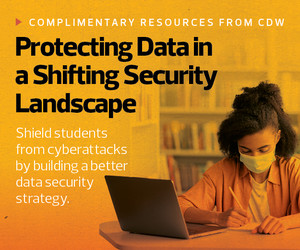“You need funding from the federal and state governments to provide resources for these schools to take action,” says David Waugh, chief revenue officer of ManagedMethods. “That’s why there’s so much attention now on E-rate and pressure on the FCC to overhaul E-rate.”
E-Rate Funding’s Limitations Exclude Needed Cybersecurity Solutions
Organizations including the Consortium for School Networking and Funds for Learning are petitioning the Federal Communications Commission to expand the technologies and solutions that qualify for E-rate funding. The funding is intended to provide broadband internet to K–12 public schools and libraries. But 99 percent of public K–12 schools in the country have had sufficient fiber-optic connections for online learning since 2019, according to a report from Education Superhighway.
E-rate covers some cybersecurity technologies at this time, including firewalls and other network products for schools. Often, these security measures don’t protect schools from risks such as third-party data breaches.
“That’s the No. 1 threat vector today, not the traditional old network, and yet there’s no funding for it,” Waugh says.
READ THE INTERVIEW: How should schools teach cybersecurity to staff and students?
Schools Can Turn to Online Resources and State Funding
School districts can find free and low-cost resources to help them manage third-party risk.
“The Department of Education has a group called the Privacy Technical Assistance Center, which does technical assistance, and it’s a fantastic resource that puts out guidance for schools,” Seigl says. “Organizations like Common Sense Media have put together a division that looks at and rates educational software privacy policies, and CoSN provides a privacy toolkit that covers understanding the laws and vetting applications. It also provides a set of 25 best practices for schools as part of its trusted learning environment.”
Moore Public Schools in Oklahoma is working on its TLE certification, but the district has also funded its data privacy and application vetting efforts with the help of the Oklahoma Society for Technology in Education.
“Our district had been phenomenal about pushing this to other districts,” Jun Kim, the district’s director of technology, says about Moore Public Schools’ efforts to earn the TLE certification. “It got the attention of our state Department of Education and folks over at the Oklahoma Office of Management and Enterprise Services.”
DIVE DEEPER: Moore Public Schools takes strong data protection measures.
There are many avenues through which schools can pursue or push for cybersecurity funding. Protecting student and staff data from third-party breaches can save schools more than money; it can protect their reputations in a world where cybercriminals are targeting the most vulnerable users.











